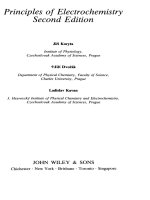Modern aspects of electrochemistry no 16 conway
Bạn đang xem bản rút gọn của tài liệu. Xem và tải ngay bản đầy đủ của tài liệu tại đây (7.96 MB, 521 trang )
MODERN ASPECTS OF
ELECTROCHEMISTRY
No. 16
Edited by
B. E. CONWAY
Department of Chemistry
University of Ottawa
Ottawa, Ontario, Canada
RALPH E. WHITE
Department of Chemical Engineering
Texas A&M University
College Station, Texas
and
J. O'M. BOCKRIS
Department of Chemistry
Texas A&M University
College Station, Texas
PLENUM PRESS • NEW YORK AND LONDON
The Library of Congress cataloged the first volume of this title as follows:
Modern aspects of electrochemistry, no. [1]
Washington, Butterworths, 1954v. illus., 23 cm.
No. 1-2 issued as Modern aspects series of chemistry.
Editors: no. 1J. Bockris (with B. E. Conway, No. 3)
Imprint varies: no. 1, New York, Academic Press.—No. 2, London , Butterworths.
1. Electrochemistry-Collected works. I. Bockris, John O'M. ed. II. Conway, B. E.
ed.
(Series: Modern aspects series of chemistry)
QD552.M6
54-12732 rev
ISBN 0-306-42024-4^
©1985 Plenum Press, New York
A Division of Plenum Publishing Corporation
233 Spring Street, New York, N.Y. 10013
All rights reserved
No part of this book may be reproduced, stored in a retrieval system, or transmitted,
in any form or by any means, electronic, mechanical, photocopying, microfilming,
recording, or otherwise, without written permission from the Publisher
Printed in the United States of America
LIST OF CONTRIBUTORS
BRIAN E. CONWAY
Department of Chemistry
University of Ottawa
Ottawa, Ontario KIN 9B4, Canada
S. EFRIMA
Department of Chemistry
Ben-Gurion University of The Negev
Beer-Sheva, Israel 84105
YU. YA. GUREVICH
A. N. Frumkin Institute of Electrochemistry
Academy of Sciences of the USSR
Moscow, USSR
A. HAMELIN
Laboratoire d'Electrochimie Interfaciale du CNRS
92195 Meudon Cedex, France
YU. V. PLESKOV
A. N. Frumkin Institute of Electrochemistry
Academy of Sciences of the USSR
Moscow, USSR
HALINA S. WROBLOWA
Ford Motor Company
Scientific Research Laboratory
Dearborn, Michigan 48121
HOWARD L. YEAGER
Department of Chemistry
University of Calgary
Calgary, Alberta T2N 1N4, Canada
RICHARD S. YEO
Pinnacle Research Institute
Cupertino, California 95014
A Continuation Order Plan is available for this series. A continuation order will bring delivery of
each new volume immediately upon publication. Volumes are billed only upon actual shipment.
For further information please contact the publisher.
Preface
This volume of the Modern Aspects of Electrochemistry series contains six chapters: four are on topics of current fundamental interest
in the subject and two deal with more technological aspects of
electrochemistry.
In Chapter 1, Antoinette Hamelin deals with the topic of
characterization of the double layer at well-defined single-crystal
faces of solid metals. She also gives valuable instructions for the
preparation and characterization of single-crystal faces of known
orientation and index which will be very useful to many workers
in this field, especially those who are just entering it as novices or
to those whose crystals are not always too accurately characterized!
Most of the work reported is concerned with crystal faces of gold
and silver which this author has specialized in studying. It is her
work in recent years that has taken experimental studies of doublelayer behavior well beyond the conventional area of research at
liquid mercury.
Chapter 2, by B. E. Conway, deals with a curious fundamental
but hitherto little-examined problem in electrode kinetics: the real
form of the Tafel equation with regard to the temperature dependence of the Tafel-slope parameter b, conventionally written as
'b = RT/ aF\ where a is a transfer coefficient. He shows, extending
his 1970 paper and earlier works of others, that this form of the
relation for b rarely represents the experimental behavior for a
variety of reactions over any appreciable temperature range. Rather,
b is of the form RT/(aH + asT)F or RT/ a'F + K, where aH and
as are enthalpy and entropy components of the transfer coefficient
(or symmetry factor for a one-step electron transfer reaction), and
K is a temperature-independent parameter, the apparent limiting
vi
Preface
value of b for some systems at T = 0. These forms for b, required
by the observed experimental behavior, imply that fundamental
aspects of the charge transfer and activation process in electrode
reactions are not at all fully understood yet. This chapter deals with
various possible interpretations of the observed T dependence of
b9 including the topic of potential dependence of the entropy of
activation of electrode processes.
The electrochemistry of semiconductors has played a major
part in the development of modern electrochemistry, especially in
recent years with regard to photoelectrochemical energy conversion
using illuminated semiconductor electrodes. Drs. Pleskov and
Gurevich of the Institute of Electrochemistry, Moscow, contribute
an important chapter (3) on "New Problems and Prospects" in this
field. Readers will find that their chapter gives a thorough account
of the current directions of development in this field, as well as
some of the difficulties and new areas of research in this subject.
Surface-enhanced Raman scattering has been regarded, in
some ways, as the spectroscopic "Godsend" to electrochemists
trying to characterize submonolayer quantities of adsorbates at
electrode interfaces. Professor S. Efrima presents, in Chapter 4, a
monumental and thoroughly referenced survey of the vast literature
on this topic that has grown in the past 14 years or so. He presents
a "personal view" of this intriguing and often controversial subject,
and attempts to distil out for the electrochemist what is of
quantitative significance in the many contributions that have been
made on this topic. He concludes by critically reviewing the various,
not always mutually exclusive, theories of the origin of the SERS
effect.
Dr. Halina S. Wroblowa, in Chapter 5, gives a valuable comparative account of the current state of the art in development of
batteries for vehicular transportation. The Laboratory at Ford,
through Kummer, has been the "prime mover" in high-energy and
power-density battery development, especially in the field of
sodium-sulfur battery systems. Dr. Wroblowa herself has, for some
years, been* an active researcher in this field at Ford, so she brings
to bear on this topic substantial experience and an authentic critical
judgment of the viability of various systems that have been
engineered over the past 10-15 years, including the latest developments.
Preface
vii
The volume ends with a chapter on "Structural and Transport
Properties of Perfluorinated Ion-Exchange Membranes" by Dr.
Richard S. Yeo and Professor Howard L. Yeager. The development
of such membranes has revolutionized the electrochemical technology of the chlorine-caustic industry and also has been of great
value in the engineering of water electrolyzers, organic preparation
cells and some designs of fuel cells. This chapter is not only of
technological interest in the above areas but deals in some detail
with fundamental problems of ion association, aggregation, membrane structure and ion transport in the solution-invaded, locally
hydrophobic medium which these polymers provide in membranes.
University of Ottawa
Texas A&M University
Texas A&M University
B. E. Conway
Ralph E. White
J. O'M. Bockris
Contents
Chapter 1
DOUBLE-LAYER PROPERTIES AT sp AND sd
METAL SINGLE-CRYSTAL ELECTRODES
A. Hamelin
I. Introduction
II. Historical
III. Structure of Metals
1. Basis of Crystallography
2. The Stereographic Projection
3. Determination of Crystallographic Orientation
4. Models of Crystal Surfaces
5. Structure of Metal Surfaces
IV. Preparation of Single-Crystal-Face Electrodes
1. Growing Single Crystals
2. Cutting the Crystal
3. Polishing and Isolating the Face of Interest
4. Final Surface Preparation
5. Ex Situ Check of State of Electrode Surface
6. In Situ Check of State of Electrode Surface
V. Electrochemical Results
1. The pzc's
2. The Solution Side of the oHp
3. The Metal Side of the oHp
4. The Roughness Factor
5. Conclusions
References
ix
1
3
4
4
6
10
15
23
28
28
32
33
36
37
38
43
45
50
58
94
96
98
x
Contents
Chapter 2
THE TEMPERATURE AND
POTENTIAL DEPENDENCE OF
ELECTROCHEMICAL REACTION RATES, AND
THE REAL FORM OF THE TAFEL EQUATION
Brian E. Conway
I. Introduction
1. Scope and Significance of this Article
2. Preliminary Definitions
3. The Tafel-Slope Parameter b
II. Origin of Potential Dependence of Electrochemical
Reaction Rates and the Conventional Role of Temperature
1. Theoretical Representations of Rates of Electrode
Processes
2. Relation of j3 to a
III. The Experimental Situation Regarding the Temperature
Dependence of Tafel Slopes
1. General Remarks
2. Documentation and Examples of the Experimentally
Observed Dependence of b on T and the Behavior
of a with T
IV. Theoretical Discussion
1. Interpretation of the Case Where a is Proportional
to T
2. General Case
3. A Question About the Electrical Energy Term /3VF
in the Rate Equation
4. Temperature-Dependent Orientation of Solvent
Dipoles in the Inner Region of the Double Layer and
the Entropy of Activation
5. Tafel Slopes and Proton Tunneling
6. Behavior of a with Temperature on the Basis of
Electron and Particle Transfer Treatment of Ulstrup
7. Nonlinear Potential Dependence of Electrochemical
Reaction Rates
103
103
104
106
107
107
115
116
116
117
132
132
134
135
138
143
147
148
Contents
xi
8. Expansion of the Helmholtz Layer with Temperature
9. Effects of Specific Adsorption of Anions
10. Tafel Slopes for Reactions Proceeding in Multistep
Pathways
11. Tafel Slopes in Relation to Exchange Current
Densities i0
12. Electrode Area and Tafel Slopes
V. Problems with Evaluation of Heats of Activation When
a is Temperature Dependent
1. Derivation of the Apparent Heat of Activation at the
Reversible Potential
2. a and the Relation between Real and Apparent Heats
of Activation
3. Experimental Evidence for the Potential Dependence
of the Entropy of Activation, AS*
VI. Conclusions and Final Remarks
References
155
156
160
164
167
168
168
175
178
182
185
Chapter 3
ELECTROCHEMISTRY OF SEMICONDUCTORS:
NEW PROBLEMS AND PROSPECTS
Yu. V. Pleskov and Yu. Ya. Gurevich
I. Introduction
II. Characteristic Energy Levels in the Electrode/Electrolyte Solution System
1. The Electrochemical Potential of Electrons in the
Solution Containing a Redox Couple
2. Relationship between the Energy Scale and the Scale
of Electrode Potentials
3. Determination of the Reorganization Energy of a
Solvent
III. Specific Features of the Structure of the Semiconductor/Electrolyte Interface
1. The Electrical Double-Layer Model
189
190
191
196
199
201
201
xii
Contents
2. Potential Distribution: "Pinning" of Band Edges
and/or the Fermi Level at the Surface
3. Determination of the Flat-Band Potential
IV. Quasithermodynamic Approach to the Description of
Photoelectrochemical Processes
1. Quasi-Fermi Levels
2. Description of the Most Important Types of Photoelectrochemical Reactions
3. Photocorrosion and Stability
4. The Limits of Applicability of the Quasi-Fermi Level
Concept in Photoelectrochemical Kinetics: Alternative Approaches
V. New Applications
1. Photoelectrochemical Conversion of Solar Energy
2. Laser Etching of Semiconductors
3. The Ion-Selective Field-Effect Transistor
4. Characterization of Semiconducting Materials
VI. Concluding Remarks
References
206
210
216
216
218
228
232
236
236
239
243
245
245
247
Chapter 4
SURFACE-ENHANCED
RAMAN SCATTERING (SERS)
S. Efrima
I. Introduction
II. SERS Experimental Studies
1. Estimate of the Enhancement Factor
2. Surface Preparation
3. Some Molecules and SERS Behavior
4. Metals (or Solids) which Exhibit SERS
5. Excitation Profiles
253
255
256
271
291
307
312
Contents
xiii
III. Theoretical Models of SERS
1. General
2. Resonance Models (RE)
3. Electric Field and Emission Enhancement Mechanisms (LFE)
4. Dyes in SERS—Theory
IV. What is "the" SERS Mechanism?
1. General
2. "The" SERS Mechanism
V. SERS—A Useful Tool
References
322
322
325
336
344
348
348
349
350
357
Chapter 5
BATTERIES FOR VEHICULAR PROPULSION
Halina S. Wroblowa
I. Introduction
1. General Remarks
2. Battery Classification
II. EV Battery Requirements
1. Performance-Related Requirements
2. Cost-Related Requirements
3. Safety and Environmental Impact
III. Characteristics of Individual Systems
1. The Lead/Acid Battery
2. The Nickel-Iron Battery
3. Zinc Batteries
4. High-Temperature Batteries
5. Rechargeable Lithium Batteries
6. Conducting Polymer Systems
7. Metal-Air Batteries
IV. Comparative EV Battery Characteristics
References
371
371
372
373
375
384
389
391
391
396
399
409
417
418
420
423
427
xiv
Contents
Chapter 6
STRUCTURAL AND TRANSPORT PROPERTIES OF
PERFLUORINATED ION-EXCHANGE MEMBRANES
Richard S. Yeo and Howard L. Yeager
I. Introduction
1. Historical Background of Ion-Exchange Membrane
Cells
2. Requirements of High-Performance Membranes . . .
3. Development of Perfluorinated Ionomer Membranes
4. Types of Applications
5. The Scope of this Review
II. Microstructure
1. Structural Studies of Ionomers
2. Eisenberg's Theory
3. Ions in Perfluorinated Ionomers
4. Structural Models of Nafion
5. Solvation Phenomena
III. Ion and Water Diffusion
1. Diffusional Properties in Dilute Solution Environments
2. Diffusion Properties in Concentrated Solution
Environments
IV. Transport Properties under Industrial Electrolysis Conditions
1. Characteristics of Perfluorinated Chlor-Alkali Membranes
2. Membrane Permselectivity in a Chlor-Alkali Cell
3. Interpretation of Permselectivity as a Function of
Membrane Properties and Cell Parameters
V. Conductivity and Permeability in Membranes
1. Conductivity in Pure Water—Solid Polymer Electrolyte Systems
2. Conductivity in Acidic Electrolytes
3. Conductivity in Alkaline Electrolytes
4. Conductivity of Nafion in Protic Solvents
437
437
438
439
440
441
441
441
443
445
447
450
459
460
465
470
471
472
475
479
480
482
485
489
Contents
xv
5. Permeation of Molecular Species
VI. Conclusion
References
490
496
497
Index
505
Double-Layer Properties at sp and sd Metal
Single-Crystal Electrodes
A. Hamelin
Laboratoire d'Electrochimie Interfaciale du CNRS,
92195 Meudon Cedex, France
I. INTRODUCTION
Writing such a chapter on solid metal electrodes is a challenge
when, at every moment, the latest developments of surface science
give rise to new possibilities and new results in this area of electrochemistry. However, an attempt will be made to give an "up-todate snapshot" of the state of affairs for the double layer at singlecrystal electrodes of metals which are not of the transition series.
Already in this Modern Aspects of Electrochemistry series the
theory and status of data for electrochemical double layers (dl)
were detailed,1"3 but the sections devoted to results obtained with
solid electrodes and their discussion were brief. Some aspects of
the dl on polycrystalline metals, such as the potential of zero charge
(pzc), were described.4 In this series a chapter was also devoted to
the metal-gas interface5; certainly the comparison of this interface
with that at an electrode is fruitful, although the local electric field
in the latter case can be varied far more easily.
Other basic books have dealt with dl properties without giving
extensive discussion of the dl at solid electrodes.6"9 Although at
the end of the 1960s and beginning of the 1970s some reliable
results had been obtained on polycrystalline metals, their analysis
suffered from the uncontrolled complexity of the surface structure.
2
A. Hamelin
This can be easily understood: When a potential is applied to an
electrode the surface is an equipotential but the different grains (of
different structures) at the surface have different densities of charge;
e.g., for a given potential the density of charge can be zero for
certain patches of the electrode, positive for others, and negative
for other ones (as long as the patches are large enough to create
their own local electrochemical dl).
It will be useful to emphasize the practical aspects of the
problem which are twofold: the solution side and the metal side.
On the solution side at the interphase, a level of impurities which
does not interfere with dl measurements over the time scale of a
mercury-drop lifetime, which is 4 s, could completely hinder
observations of significant current-potential curves [*(£)] or meaningful differential capacity-potential curves [C(E)] at a solid metal
electrode which will stay 2, 3, or 4 h in the same solution. Not only
must the water, salts, and glassware be kept clean, but also the gas
used to remove oxygen and the tubing for the gas. Of course,
conditions are less drastic for studies of strong adsorption than in
the case of no adsorption; also bacteria develop less in acid solutions
than in neutral ones (which cannot be kept "uncontaminated" more
than one or two days). This aspect will not be discussed in this
chapter.
The metal side of the electrochemical interphase must also be
rigorously controlled. For crystal faces, this includes not only the
chemical state but also the physical state of the top layers of atoms
at the surface (layers: 0,1,2 at least). Each metal brings specific
difficulties—e.g., one oxidizes in air, another does not; one has a
low melting point, another a high melting point; one is hard, another
is soft, etc. Practical requirements which are satisfactory for one
metal are not necessarily valid for another one. This aspect of the
problem is the subject of this chapter.
Both sides of the interface must be rigorously clean for observations of the dl. The beginner will ask, "How can I know that my
interphase is clean?" He or she will be able to answer this question
by: observation of the i(E) curve in the dl range of potential;
observation of the contribution of the diffuse part of the dl on the
C(E) curves in dilute solutions (in the case of no specific adsorption); comparison of the i(E) and C(E) curves; observing the
stability of these two curves; etc. Comparison with the results
Double-Layer Properties at Metal Electrodes
3
published for polycrystalline electrodes of one metal gives indications of what should be observed at faces of this metal (as long as
they were obtained with great care). Furthermore, as ex situ and
nonelectrochemical in situ methods become increasingly available
in laboratories, they will contribute to the control and understanding
of the electrochemical interphase.
II. HISTORICAL
A review paper10 published in 1983 gives all references for dl work
at sp and sd metal faces up to July 1982, since then, numerous
other papers were published.
As in any rapidly developing field, many publications can claim
little more than being the first to examine such faces of a particular
metal in given conditions. All publications except one (Ref. 11)
deal with results obtained in the aqueous solvent; all publications
except two (Refs. 12 and 13) deal with results obtained at room
temperature. Faces of only seven nontransition metals were studied
(Ag, Au, Cu, Zn, Pb, Sn, and Bi). Only for gold has a large number
of high-index faces been studied in order to give a general view of
the influence of the crystallographic orientation (co) of the electrode
surface; these faces are distributed only on the three main zones
of the unit projected stereographic triangle (see Section III.2), so
it would be interesting to make faces having co's which are inside
this triangle.
From 1956 to the end of the 1960s dl properties were studied
by conventional electrochemical methods, but during the last
decade a number of results obtained by optical measurements or
other physical methods were published. It is sometimes difficult to
determine whether a paper pertains to the study of dl properties
or to the study of the metal surface properties in the presence of
the electrochemical dl. All are of interest to electrochemists who
work with metal faces.
Anyway, experimental results on well-defined faces of nontransition metals are more and more numerous every year; their
understanding is related to the theories developed not only from
results obtained on mercury but also from knowledge of solid
surfaces.
4
A. Hamelin
III. STRUCTURE OF METALS
1. Basis of Crystallography
The essential characteristic of a single crystal is the periodic nature
of its structure. Its atomic structural arrangement can be related to
a network of points in space called the lattice. The coordinates of
a given point in a lattice (or atom in a structure) are referred to as
the crystal axes, for instance, for the cubic system, axes at right
angles to each other. Seven different systems of axes are used in
crystallography and there are seven crystal systems. The axes form
the edges of a parallelopiped called the unit cell which is the
fundamental building block of the crystal. The unit cell has a definite
atomic arrangement with lattice points at each corner and, in some
cases, lattice points at the center of the face or at the center of the
volume.
Most of the metals crystallize in the cubic system (face centered, body centered). Zn and Cd crystallize in the hexagonal system, Bi in the rhombohedral system, and Sn in the tetragonal
system. In this chapter emphasis will be placed on the cubic system, for Au, Ag, Cu, Pb, and so forth, are face-centered-cubic
metals (fee).
Miller indices are universally used as a system of notation for
faces of a crystal. The orientation of the plane of a face is given
relative to the crystal axes and its notation is determined as follows:
1. Find the intercepts on the axes.
2. Take their reciprocals.
3. Reduce to the three (or four for the hexagonal closepacked (hep) systemt) smallest integers having the same
ratio.
4. Enclose in parentheses, e.g., (hkl).
All parallel planes have the same indices. Negative intercepts
result in indices indicated with a bar above. Curly brackets signify
a family of planes that are equivalent in the crystal—the six different
t A system of rectangular axes could also be used for hep structure; a four-axes
system is preferred where three axes are drawn on the basal hexagon and the
fourth axis perpendicularly. Therefore, four Miller jndices are necessary to give
the position of a plane: {0001} is the basal plane, {1100} the prism plane, andthe
third apex of the unit projected stereographic triangle (see Section III.2) is {1120}.
Double-Layer Properties at Metal Electrodes
faces of a cube, for instance, or the family of planes {110} which is
{110} = (110) + (Oil) + (101) + (TiO) + (llO) + (Oil)
+(oil)+(IOT)+(Toi)+(TiO)+(ToT)+(oil)
All these planes have the same atomic configuration. For pure
metals the high level of symmetry allows us to write indifferently
parentheses or curly brackets. The Miller indices of some important
planes of the cubic and the hexagonal close-packed systems are
given in Fig. 1.
(100)
(a)
(110)
(102)
(111)
(113)
--(0001)
(1120)
(1100) -
(1010)
1
(b)
Figure 1. (a) The three rectangular axes and the (111) plane for the
cubic system. Some important planes and their Miller indices for
the cubic system are shown, (b) The four axes and some important
planes for the hexagonal close-packed system.
6
A. Hamelin
Any two nonparallel planes intersect along a line; they are
planes of a zone and the direction of their intersection is the zone
axis. A set of crystal planes which meet along parallel lines is known
as planes of a zone. The important zones in a crystal are those to
which many different sets of planes belong. On a crystal the faces
of a zone form a belt around the crystal. Zones are useful in
interpreting X-ray diffraction patterns (see Section III.3). Zones
are denoted [hkl].
For a detailed study of Section III, the reader can refer to a
universally accepted textbook—Reference 14.
2. The Stereographic Projection
The angular relationships among crystal faces (or atomic planes)
cannot be accurately displayed by perspective drawings; but if they
are projected in a stereographic way they can be precisely recorded
and then clearly understood.
Let us assume a very small crystal is located at the center of
a reference sphere (atomic planes are assumed to pass through the
center of the sphere). Each crystal plane within the crystal can be
represented by erecting its normal, at the center of the sphere, which
pierces the spherical surface at a point known as the pole of the
Figure 2. Angle <f> between two poles measured
on a great circle.
Double-Layer Properties at Metal Electrodes
plane. The angle between any two planes is equal to the angle
between their poles measured on a great circle of the sphere (in
degrees) as in Fig. 2.
As it is inconvenient to use a spherical projection to determine
angles among crystal faces or angular distances of planes on a zone,
a map of the sphere is made, so that all work can be done on flat
sheets of paper.
The simple relation between the reference sphere and its stereographic projection (its map) is easily understood, by considering
the sphere to be transparent and a light source located at a point
on its surface (see Fig. 3). The pattern made by the shadows of the
poles which are on the hemisphere opposite to the light source,
falls within the basic circle shown on the figure. The other hemisphere will project outside the basic circle and extend to infinity.
To represent the whole within the same basic circle the light source
is put on the left and the screen tangent to the sphere on the right
side; the points of this latter hemisphere are distinguished from
those of the first by a notation such as plus and minus. All plotting
can be done by trigonometric relationships directly on graph paper.
;— Projection plane
Light
'source
Reference
sphere
Basic c.rcle
Figure 3. Stereographic projection. Pole
P of the crystallographic plane projects to
P' on the projection plane (Ref. 14).
8
A. Hamelin
The projection of the net of latitude and longitude lines of the
reference sphere upon a plane forms a stereographic net—the Wulff
net (Fig. 4). The angles between any two points can be measured
with this net by bringing the points on the same great circle and
counting their difference in latitude keeping the center of the
projection at the central point of the Wulff net.
Stereographic projections of low-index planes in a cubic crystal
and in a hep crystal are given in Fig. 5. Only one side of the
projection is visible; thus it must not be forgotten that "below"
(001) there is (OOl), "below" the planes of the {111} family represented on Fig. 5a there are the (ITT), (111), (111), and (III) planes,
and so on for other families of planes. This fact must be kept in
Figure 4. Stereographic net, Wulff or meridional type, with 2° graduation (Ref. 14).
Double-Layer Properties at Metal Electrodes
9
mind when assessing the faces to simulate an "ideal" polycrystalline
surface from three or more families of faces.15
For electrochemists using single-crystal electrodes, the high
level of symmetry of the crystal of pure metals allows all types of
planes to be represented on a single triangle—the unit projected
stereographic triangle. The co of a face is represented by a single
point; therefore the azimuthal orientation is not specified. When
important, the azimuth is added; it is denoted [Me/]. Any co can
be represented on the unit projected triangle; this is done for faces
of high indices on a figure presented in Section III.4.
Some of the most important angles between the faces are given
in Table 1.
r
213
X
) 130
\
102
) 150
) 103
113
\
013
/
013
/
-Voui"
113
1113
)103
) 150
u
213
213
') 130
Figure 5 (a) Standard (001) stereographic projection of poles and zones circles
for cubic crystals (after E A. Wood, Crystal Orientation Manual, Columbia Univ.
Press, New York, 1963).
10
A. Hamelin
2310
Figure 5. (b) Standard (0001) projection for zinc (hexagonal, c/a = 1.86) (Ref. 14).
3. Determination of Crystallographic Orientation
The diffraction of X-rays by a crystal, i.e., by a three-dimensional
grating, is analogous to the diffraction of light by a one-dimensional
grating. When the incident and scattered rays make equal angles
with the atomic plane there is reinforcement—the atomic plane
behaves like a mirror that is reflecting a portion of the X-rays. The
geometry of the lattice determines entirely the direction of the
reflected beams, i.e., the reflected beams are governed by the distribution of atoms within the unit cell following Bragg's law and the
Laiie equations.14
By using these principles the electrochemist has only to find
out the co of a piece of metal which was recognized as being an
i
Table 1
Symmetries and Angular Specifications of Principal Index Faces of Single Crystals
Face of reference
(100)
(HI)
(101)
Symmetry of the
spots around
this face
Fourfold
Threefold
Twofold
Angles between the
zones intersecting
at this face
Angles between the
face of reference
and the low-index
faces or the
low-index zones
;}.
[010][011] = 45.00°
[010][031] = [001][013] = 18.30°
[010][021] = [001][012] = 26.56°
[10l][0lI] = 60.00°
[101][213] = [011][123] = 19.10°
[101][112] = 30.00°
[010][101]
[010][141]
[101][323]
[101][lll]
[101][313]
=
=
=
=
=
90.00°
19.46°
[010][131] = 25.23°
[010][121] = 35.26°
13.26°
[OlO]
[Oil]
[031]
[iol]
[Oil]
[112]
[101]
[010]
[111]
601 9.46°
501 11.31°
401 14.03°
301 18.43°
502 21.80°
201 26.56°
503 30.85°
302 33.41°
705 35.51°
403 36.86°
605 39.81°
101 45.00°
711 11.41°
611 13.26°
511 15.78°
411 19.46°
31125.26°
733 31.21°
21135.26°
533 41.08°
322 43.31°
755 45.28°
433 46.66°
11154.73°
913 19.36°
813 21.58°
713 24.30°
613 27.80°
513 32.30°
413 38.50°
545 5.76°
323 10.03°
535 12.27°
212 15.80°
737 18.41°
525 19.46°
313 22.00°
515 27.21°
101 35.26°
655 5.03°
433 7.96°
755 9.45°
322 11.41°
533 14.41°
955 16.58°
211 19.46°
733 23.51°
31129.50°
534 11.53°
957 13.13°
423 15.23°
735 18.08°
312 22.20°
717 5.76°
515 8.05°
414 10.13°
727 11.41°
313 13.26°
525 15.80°
737 16.86°
212 19.46°
535 22.98°
323 25.23°
605 5.18°
403 8.13°
302 11.31°
503 14.05°
201 18.43°
703 21.80°
502 23.20°
301 26.40°
401 30.96°
501 33.68°
601 35.53°
100 45.00°
817 6.41°
615 8.95°
514 10.90°
413 13.95°
312 19.10°
523 23.41°
734 25.28°
21130.00°
M
|
12
A. Hamelin
individual crystal (see Section IV.2); the metal crystal system and
the crystal parameters can then be found in handbooks.
The most convenient method for determining the co of an
individual crystal is the back-reflection Laiie method. This method
requires only simple equipment: the crystal is positioned in a
goniometer head (or any instrument which provides adjustable
orientation) and a flat X-ray film in a lightproof holder is mounted
normal to the X-ray beam. The film must be at a precise distance
R from the crystal (3, 6, or 12 cm) (Fig. 6).t
The interpretation of the photograph obtained after about
20 min, is carried outt by making use of a chart developed by
Greninger16 (Fig. 7), a standard projection of the crystal system
(Fig. 5 for the cubic system), and a table of the angles between the
different faces (Table 1 for the cubic system).
For planes in a given zone, which form a belt around the
crystal, a cone of reflected X-rays cuts the film along a hyperbola.
The closest approach of the hyperbola to the center of the film is
equal to #tan2</>, where <j> is the angle of inclination of the zone
axis (to the plane of the film). When the zone axis is parallel to
the film the hyperbola degenerates into a straight line passing
through the center of the film. A back-reflection pattern of a fee
crystal (gold) is shown in Fig. 8. The circle at the center is due to
the punched hole necessary for the pinhole collimator of the
incident X-ray beam. The spots on one row (a hyperbola) are
reflections from various planes of one zone.
First, attention is directed only to hyperbolas densely packed
with spots and to spots which lie at the intersections of these
hyperbolas. These spots correspond to low-index planes: (100),
(110), and (111) (for the fee system). Their symmetry—easily
observed—allows indices to be tentatively assigned to them. The
assigned indices are checked by reading the angles between the
planes (the spots) on a zone (a hyperbola) using Table 1. A Grenint Tungsten target X-ray tubes are convenient for this work. Place a small piece of
metal on the lower right-hand side of the black paper which covers the film, so
as to have a guidemark on the film.
X The film must be read from the side on which the reflected rays were incident.
When, after developing, the film is dry, it is advisable to reproduce it on tracing
paper using ink. Then the supposed zones and angles are drawn with pencil so
that they can be easily erased if mistaken.









